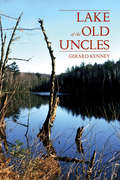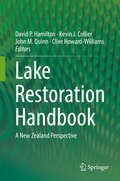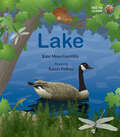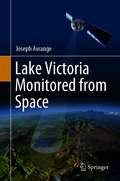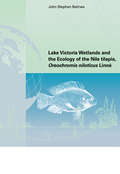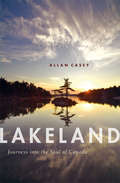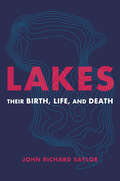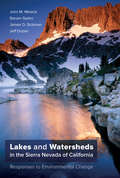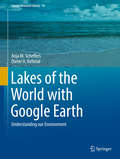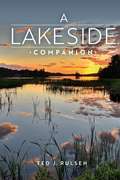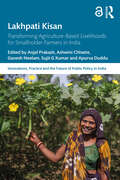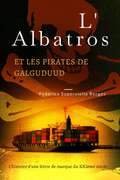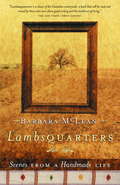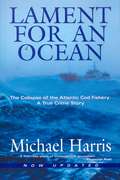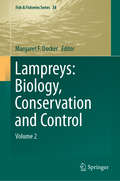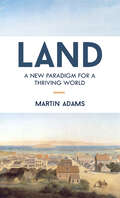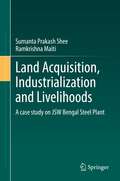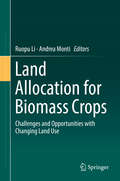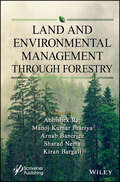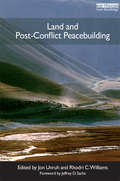- Table View
- List View
Lake Nipigon: Where the Great Lakes Begin
by Nancy Scott2017 Gertrude H. Dyke Award — Nominated The history of Lake Nipigon, where the Great Lakes begin. The name Nipigon is evocative of storied brook trout, cold clear waters, elusive woodland caribou, sweeping vistas, and spectacular scenery. Situated in the heart of Northwestern Ontario, almost every map of North America shows Lake Nipigon as a significant geographic feature, yet few people know its story. As the primary watershed that flows into Lake Superior, Nipigon is the headwaters of the Great Lakes. This, the first inclusive historical account of Lake Nipigon, provides a fascinating overview of its extensive natural history, including information on species at risk, and interprets the story of human incursion into the area, from its aboriginal prehistory to the colourful fur trade, the harvesting of resources, the coming of the railway, recreational fishing, eventual settlement, and the communities that remain today.
Lake of the Old Uncles
by Gerard KenneyLake of the Old Uncles recounts a trip that began three-quarters of a century ago in a small village inn nestled in the Laurentian hills of French-speaking Quebec. One day, the trip will end at the village cemetery, just one kilometre from the inn. The traveller is the author. The trip is not long, but is rich in rural and natural experiences along the way. Gerard Kenney takes us along the route that led him to build the lone log cabin on the small and inaccessible Lake of the Old Uncles. No roads reach the pond, only a footpath. The hours spent in the quietude of the forest cabin have had an effect on the author that has resulted in a personal philosophy, both rural and natural, inspired by his hero, Henry David Thoreau. Gerard Kenney shares with his readers the evolution of his philosophy through his personal experiences with people and with the wilderness flora and fauna he has encountered on his life’s journey.
Lake Restoration Handbook: A New Zealand Perspective
by David P. Hamilton Kevin J. Collier John M. Quinn Clive Howard-WilliamsLakes across the globe require help. The Lake Restoration Handbook: A New Zealand Perspective addresses this need through a series of chapters that draw on recent advances in modelling and monitoring tools, citizen science and First Peoples’ roles, catchment and lake-focused restoration techniques, and policy implementation. New Zealand lakes, like lakes across the globe, are subject to multiple pressures that have increased in severity and scale as land use has intensified, invasive species have spread and global climate change becomes manifest. This books builds on the popular Lake Managers Handbook (1987), which provided guidance on undertaking investigations into, and understanding lake ecosystems in New Zealand. The Lake Restoration Handbook: A New Zealand Perspective synthesises contemporary issues related to lake restoration and rehabilitation, integrated with social science and cultural viewpoints, and complemented by authoritative topic-area summaries by renowned scientists and practitioners from across the globe. The book examines the progress of lake restoration and the new and emerging tools available to managers for predicting and effecting change. The book will be a valuable resource for natural and social scientists, policy writers, lake managers, and anyone interested in the health of lake ecosystems.
Lake: A See to Learn Book (See to Learn #2)
by Kate Moss GamblinLake: A See to Learn Book, the second book in the See to Learn series, is designed to inspire scientific curiosity, appreciation of beauty and connection to the natural world, through gentle questions and vibrant illustrations. Lake: A See to Learn Book is the second title in a series of non-fiction picture books for very young children that uses lyrical language to encourage a sensitive perception of the natural world and a caring connection with it. The text asks young readers to consider what they see and experience at a lake through the seasons — from dragonflies and hummingbirds in summer, to crimson leaves in fall, to goslings on the lake’s icy surface in winter, to moose calves by the water’s edge in spring — drawing local connections alongside those of a global sensibility. Gorgeous illustrations show a child and adult appreciating the lake’s beauty, learning its secrets and enjoying moments of wonder, all first steps toward developing a lifelong awareness of our interconnectedness to the Earth and our impact on the environment. Includes suggestions for further reading and an author’s note regarding aspects of shaping our inner environmental compass. Key Text Features author's note further reading Correlates to the Common Core State Standards in English Language Arts: CCSS.ELA-LITERACY.RL.1.4 Identify words and phrases in stories or poems that suggest feelings or appeal to the senses.
Lake Victoria Monitored from Space
by Joseph AwangeThis book employs a suite of remotely sensed products and advanced technologies to provide the first comprehensive space-based sensing of Lake Victoria, the world’s second largest freshwater lake that supports a livelihood of more than 42 million people, modulates regional climate, but faces myriads of challenges. Proper understanding of the lake and changes in its physical dynamics (e.g., water level, shorelines and areal dynamics) resulting from the impacts of climate variation and climate change as well as anthropogenic (e.g., hydropower and irrigation) is important for its management as well as for strategic development before, during and after climate extremes (e.g., floods and droughts) in order to inform policy formulations, planning and mitigation measures. Owing to its sheer size, and lack of research resources commitment by regional governments that hamper its observations, however, it is a daunting task to undertake studies on Lake Victoria relying solely on in-situ “boots on the ground” measurements, which are sparse, missing in most cases, inconsistent or restricted by governmental red tapes. To unlock the potentials of Lake Victoria, this book argues for the removal of obsolete Nile treaties signed between Britain, Egypt and Sudan in the 1920s and 1950s, which prohibits its utilization by the upstream countries. The book is useful to those in water resources management and policy formulations, hydrologists, environmentalists, engineers and researchers.In a unique cross-disciplinary approach, the Book articulates the various climatic impacts and explanations from natural and anthropogenic origins, which affected Lake Victoria and its vicinity, including the drastic increase and depletion of water level in the Lake and dams, floods and droughts, water quality/security, crop health, food security, and economic implications. With no exception as in his many publications, Joseph L. Awange used data analysis methodologies including filtering, adjustment theory, and robust statistics, to quantify the hydrologic and other parameters, and their estimated uncertainties. The Book is recommended for readers from a diverse disciplines, including physical and social sciences, policy, law, engineering, and disaster management. Professor C.K. Shum, Ohio State University.
Lake Victoria Wetlands and the Ecology of the Nile Tilapia
by John Stephen BalirwaThis volume is taken from an ecological study of wetlands undertaken in northern Lake Victoria (East Africa) between 1993 and 1996 with the major aim of characterizing shallow vegetation-dominated interface habitats, and evaluating their importance for fish, in particular, for the Nile tilapia.
Lakeland
by Allan CaseyLakes define not only Canada's landscape but the national imagination. Blending writing on nature, travel, and science, award-winning journalist Allan Casey systematically explores how the country's history and culture originates at the lakeshore. Lakeland describes a series of interconnected journeys by the author, punctuated by the seasons and the personalities he meets along the way including aboriginal fishery managers, fruit growers, boat captains, cottagers, and scientists. Together they form an evocative portrait of these beloved bodies of water and what they mean, from sapphire tarns above the Rocky Mountain tree line to the ponds of western Newfoundland.
Lakes: Their Birth, Life, and Death
by John Richard Saylor&“Lakes is my favorite kind of natural history: meticulously researched, timely, comprehensive, and written with imagination and verve.&”—Jerry Dennis, author of The Living Great Lakes Lakes might be the most misunderstood bodies of water on earth. And while they may seem commonplace, without lakes our world would never be the same. In this revealing look at these lifegiving treasures, John Richard Saylor shows us just how deep our connection to still waters run. Lakes is an illuminating tour through the most fascinating lakes around the world. Whether it&’s Lake Vostok, located more than two miles beneath the surface of Antarctica, whose water was last exposed to the atmosphere perhaps a million years ago; Lake Baikal in southern Siberia, the world&’s deepest and oldest lake formed by a rift in the earth&’s crust; or Lake Nyos, the so-called Killer Lake that exploded in 1986, resulting in hundreds of deaths, Saylor reveals to us the wonder that exists in lakes found throughout the world. Along the way we learn all the many forms that lakes take—how they come to be and how they feed and support ecosystems—and what happens when lakes vanish.
Lakes and Watersheds in the Sierra Nevada of California: Responses to Environmental Change (Freshwater Ecology Series #5)
by John M. MelackThe Sierra Nevada, California’s iconic mountain range, harbors thousands of remote high-elevations lakes from which water flows to sustain agriculture and cities. As climate and air quality in the region change, so do the watershed processes upon which these lakes depend. In order to understand the future of California’s ecology and natural resources, we need an integrated account of the environmental processes that underlie these aquatic systems. Synthesizing over three decades of research on the lakes and watersheds of the Sierra Nevada, this book develops an integrated account of the hydrological and biogeochemical systems that sustain them. With a focus on Emerald Lake in Sequoia National Park, the book marshals long-term limnological and ecological data to provide a detailed and synthetic account, while also highlighting the vulnerability of Sierra lakes to changes in climate and atmospheric deposition. In so doing, it lays the scientific foundations for predicting and understanding how the lakes and watersheds will respond.
The Lakes of Pontchartrain: Their History and Environments
by Robert W. HastingsA vital and volatile part of the New Orleans landscape and lifestyle, the Lake Pontchartrain Basin actually contains three major bodies of water—Lakes Borgne, Pontchartrain, and Maurepas. These make up the Pontchartrain estuary. Robert W. Hastings provides a thorough examination of the historical and environmental research on the basin, with emphasis on its environmental degradation and the efforts to restore and protect this estuarine system. He also explores the current biological condition of the lakes. Hastings begins with the geological formation of the lakes and the relationship between Native Americans and the water they referred to as Okwa'ta, the “wide water.” From the historical period, he describes the forays of French explorer Pierre Le Moyne D'Iberville in 1699 and traces the environmental history of the basin through the development of the New Orleans metropolitan area. Using the lakes for transportation and then recreation, the surrounding population burgeoned, and this growth resulted in severe water pollution and other environmental problems. In the 1980s, the Lake Pontchartrain Basin Foundation led a concerted drive to restore the lakes, an ongoing effort that has proved significant.
Lakes of the World with Google Earth
by Anja M. Scheffers Dieter H. KelletatFeaturing satellite imagery from Google Earth, this guide provides a unique, highly visual tour of lakes across the globe, from the simple to the complex, the nearby to the remote. Clear text accompanies each image and identifies important aspects of each lake along with such information as its coordinates, scale, and altitudes, if relevant. From the many aspects of lake science including water budgets, temperature regimes, mixing types, biology/ecology, and chemistry, the book concentrates on the genesis of lakes and other closed forms containing water, moisture/swamps or minerals. Its organisation follows different forms of lake origin (often connected to the question of age) such as extra-terrestrial meteor impacts, structural depressions by tectonic activity, patterning of joints or faults, volcanic origin, or the forming influence of glacier ice, subterranean permafrost, littoral processes, running water, wind, and solution of rocks (karst forms). Coverage also deals with temporal variations in lake existence within the context of climate change in the past and the future. In addition, special chapters are devoted to saline (or salt) lakes, and -- in their evaporated forms -- to saltpans. Providing essential information at a glance, this guide will be help both specialists and general readers better understand the world's lakes as well as see them in a new perspective.
A Lakeside Companion
by Ted J. RulsehWhy do fish jump? Why don't lakes freeze all the way down to the bottom? Which lake plants are invasive? What are those water bugs? Is that lake healthy? Whether you fish, paddle, swim, snowshoe, ski, or just gaze upon your favorite lake, A Lakeside Companion will deepen your appreciation for the forces that shape lakes and the teeming life in and around them. You'll discover the interconnected worlds of a lake: the water; the sand, gravel, rocks, and muck of the bottom; the surface of the lake; the air above; and the shoreline, a belt of land incredibly rich in flora and fauna. Explained, too, are the physical, biological, and chemical processes that determine how many and what kinds of fish live in the lake, which plants grow there, the color and clarity of the water, how ice forms in winter and melts in spring, and much more. Useful advice will help you look out for your lake and advocate for its protection.
Lakhpati Kisan: Transforming Agriculture-Based Livelihoods for Smallholder Farmers in India (Public Policy in India)
by Anjal Prakash, Ashwini Chhatre, Ganesh Neelam, Sujit G Kumar and Apurva DudduAgriculture plays an essential role in the growth of developing economies, as agricultural production is key to food security and is closely intertwined with the livelihoods of many. This book explores the lives of smallholder agricultural farmers in India and the dire challenges that agricultural households face.Focussing on the Lakhpati Farmers initiative, the book examines interventions made by the programme to economically empower farmers and accelerate income growth in the agriculture sector. The programme, initiated by the Collectives for Integrated Livelihood Initiatives (CInI) in the tribal belts of central Indian states, helped farmers earn over INR 100,000 (or one lakh – hence Lakhpati) per annum. The programme engaged with households in 12 districts across 4 states – Jharkhand, Odisha, Maharashtra, and Gujarat – to bring about change through economic empowerment and improve the quality of life of tribal communities. This book documents these initiatives and strategies to meet the aspirations of small and marginal farmers by understanding the ingredients, processes, and challenges involved. The book analyses the programme, examines case studies, and offers ways forward.Part of the Innovations, Practice and the Future of Public Policy in India series, this volume will interest students and researchers of agriculture and rural development, business management, governance, public policy, development studies, and sociology.This book is freely available as a downloadable Open Access PDF at http://www.taylorfrancis.com under a Creative Commons (CC-BY-NC-ND) 4.0 license.
L'Albatros et les pirates de Galguduud: L'histoire d'une lettre de marque du XXIème siècle
by Federico Supervielle BergésLes camps de pirates qui parsèment la côte somalienne menacent de détourner tout bateau qui s'approche d'eux, mais les pays développés ne semblent pas capables de faire face à ce problème. L'industrie mondiale de l'énergie est sur le point de s'effondrer : un homme d'affaires sera-t-il capable de faire face aux pirates ? l'État somalien en faillite sera-t-il capable de contrôler ses propres côtes ? Un jeune marin de Cadix, fuyant ses problèmes personnels, est choisi pour en finir avec les ennemis du magnat, mais même l'océan Indien n'est pas assez loin de son passé. Au fur et à mesure que les événements se déroulent, il pressent un complot plus complexe derrière les attaques. Sans s'en rendre compte, Pablo est entraîné au centre d'une conspiration internationale dans laquelle il ne peut compter que sur l'aide de so,n équipage et de son navire : l'Albatros.
Lambsquarters: Scenes from a Handmade Life
by Barbara McleanAt the age of twenty-four, Barbara McLean and her husband, Thomas, decided to make their home in the country, near a village called Alderney in Grey County, Ontario. Together they became homeowners, farmers and, eventually, parents. They called their farm Lambsquarters, and they remain there today, twenty-six years later. Life on a farm is a cycle of never-ending work and discovery. Barbara and her family develop close relationships with every living thing: the hearty lambs and the fragile ones, the pumpkins and the potatoes and the hollyhocks in the barnyard, a family of bluebirds with problems of its own. What at first seems an intensely independent act -- having one's own land and space -- becomes more meaningful once it becomes possible to connect with the larger community. Strong bonds are formed with neighbours who share both in grief and in celebration.In striking portraits that are intensely intimate and yet reverberate with the universal hum of life, Barbara McLean describes the beauty, pain and wonder of the very essence of her surroundings and all who share them. We accompany her on a life's journey, from a somewhat daunted dweller of a ramshackle farmhouse to a true inhabitant of a place. Lambsquarters is for everyone who has dreamed of reconnecting with the land, as well as for those already well acquainted with rubber boots, chicken manure and the long trajectories of the rural school bus.
Lament for an Ocean: The Collapse of the Atlantic Cod Fishery
by Michael HarrisThe northern cod have been almost wiped out. Once the most plentiful fish on the Grand Banks off the coast of Newfoundland, the cod is now on the brink of extinction, and tens of thousands of people in Atlantic Canada have been left without work by a 1992 moratorium on fishing the stock. Today, the Pacific salmon stocks are in similar trouble – victims of the same blind, stupid greed. Angry, accusatory fingers have been pointed at various possible culprits for the collapse of the cod – at the Spanish and Portuguese, who for hundreds of years sent ever-bigger fleets to the Grand Banks; at the factory-freezer trawlers, which “vacuumed” the ocean floor for the prized fish; at those inshore fishermen who circumvented the rules governing the fishery; at the federal Department of Fisheries and Oceans, which is responsible for managing the fishery; at the harp seal, the cod’s competitor for food, whose numbers have exploded in recent years; even at Nature, for lowering the temperature of the ocean. InLament for an Ocean,the award-winning true-crime writer Michael Harris investigates the real causes of the most wanton destruction of a natural resource in North American history since the buffalo were wiped off the face of the prairies. The story he carefully unfolds is the sorry tale of how, despite the repeated and urgent warnings of ocean scientists, the northern cod was ruthlessly exploited.
Lampreys: Volume 2 (Fish & Fisheries Series #38)
by Margaret F. DockerThis book, published in two volumes, provides the most comprehensive review of lamprey biology since Hardisty and Potter’s “The Biology of Lampreys” published more than 30 years ago. This second volume offers a synthesis of topics related to the lamprey gonad (e.g., lamprey sex ratios, sex determination and sex differentiation, sexual maturation, and sex steroids), the artifical propagation of lampreys, post-metamorphic feeding and the evolution of alternative feeding and migratory types, the history and status of sea lamprey control in the Laurentian Great Lakes and Lake Champlain, and an overview of contributions of lamprey developmental studies for understanding vertebrate evolution.
Lana's World: Let's Have A Parade! (Green Light Readers)
by Erica Silverman Jess Jess GoldenUnable to interest her parents, her brothers, or even her dog in having a parade in the rain, Lana lines up her toys in the hallway and is soon leading the parade of her dreams.
Land: A New Paradigm for a Thriving World
by Martin AdamsWhat if we lived in a world where everyone had enough? A world where everyone mattered and where people lived in harmony with nature? What if the solution to our economic, social, and ecological problems was right underneath our feet? Land has been sought after throughout human history. Even today, people struggle to get onto the property ladder and view real estate as an important way to build wealth. Yet, as the reader will discover through this book, the act of owning land—and our urge to profit from it—causes economic booms and busts, social and cultural decline, and environmental devastation. Land: A New Paradigm for a Thriving World introduces a radically new economic model that ensures a more fair and abundant reality for everyone. It is a book for those who dream of a better world, for themselves and future generations.Table of ContentsIntroduction Part I: The Cost of Ignorance1. The Production of Wealth 2. The Value of Location3. The Free Market4. Social Decline5. Business Recessions6. Ecocide7. Earth, Our HomePart II: A New Paradigm for a Thriving World8. Restoring Communities9. Keep What You Earn, Pay for What You Use10. Local Autonomy11. Affordable Housing12. Thriving Cities13. Sustainable Farming14. The Price of Peace15. A New ParadigmEpilogue: A Personal NoteAppendix: The Math Behind the ScienceReferences & Suggestions for Further ReadingEndnotesIndex
Land Acquisition, Industrialization and Livelihoods: A case study on JSW Bengal Steel Plant
by Ramkrishna Maiti Sumanta Prakash SheeThis book provides an assessment of the impacts of human intervention on the natural environment and peoples' livelihoods through land-use conversion due to industrialization. Problems of land acquisition and the execution thereof have varying consequences that depend on the specific geographical as well as socio-political contexts in which they occur. This book covers a specific study of JSW Bengal Steel Ltd., which in 2014 planned to set up a 10.0 million ton per year integrated steel plant at the upper catchment of Sundra basin, the tributary of the Shilabati that ultimately pours to the river Rupnarayan, located at Salboni Block of Paschim Medinipur, West Bengal, India. The project was ultimately put on hold, but caused many lingering environmental and socioeconomic problems due to the acquisition of formerly productive lands. The book examines this case to generate a database on the different aspects of land acquisition and its negative impacts on the geomorphology and hydrological of non-timber forest products, agricultural impacts resulting in livelihood changes, policy dimensions of land acquisition, and the impacts of delays in project implementation through a comparative analysis between projects-affected areas and non-project areas. The book will appeal to environmental managers and industry workers, as well as students and researchers in environmental economics, anthropology, and human geography.
Land Allocation for Biomass Crops: Challenges and Opportunities with Changing Land Use
by Andrea Monti Ruopu LiThis edited volume establishes a forum for international experts to explore cutting-edge questions associated with the land use and biomass production. Topics include ‘do we have enough land, either primary or marginal, to accommodate future production of biomass?’, ‘how are farming decisions made in response to biomass incentives?’, ‘is the current bio-mass production socially, economically and environmentally sustainable?’, and ‘what are the main constraints currently limiting biofuel deployment?’ The expansion of biomass production is often at the cost of reduced land availability for food production and losses of areas with ecological functions such as forests and wetlands. This process often involves complex interplay of physical dynamics and human systems that are driven by numerous geographic and socio-economic factors at different scales. Thus, the state-of-the-art research on the land use issues surrounding the biomass production and its environmental impacts is important for informed land management decision making. This book will be of great use to researchers in land use management and biomass-based renewable energy, as well as practitioners.
Land and Environmental Management Through Forestry
by Abhishek Raj Manoj Kumar Jhariya Arnab Banerjee Sharad Nema and Kiran BargaliLAND AND ENVIRONMENTAL MANAGEMENT THROUGH FORESTRY Written and edited by a group of experts in the field, this groundbreaking reference work sets the standard for engineers, students, and professionals working in forestry, agriculture, ecology, and environmental science, offering the scientific community a way toward combating climate change and land degradation. This outstanding new volume covers the diverse issues of land degradation around the world and its restoration through forestry, agroforestry, and other practices. The editors have integrated many different concepts and applications into a single place from which scientists, research scholars, academicians, and policymakers can be bene???t. New insights in this area are critical, as our very existence depends on forest sustainability and land restoration management. The work consists of chapters addressing the issues of land degradation, deforestation, intensive agricultural practices, sustainable intensification, soil and forest-related services, land and environmental management, and overall sustainability of the ecosystem. The contributors address current issues and their management through a holistic and integrated approach, presenting the context of land degradation and its problem, identifying the potential areas of research in the field of land restoration, identifying the land-based services and their potential role for ecosystem sustainability, creating awareness so that future policies can be framed for the betterment of human civilization, and addressing sustainable intensification for land and environmental management and service. A standard reference work for the disciplines of forestry, agriculture, ecology, and environmental science, it will also be a way forward for combating climate change. Useful to academics, researchers, ecologists, environmentalists, students, capacity builders, and policymakers, it is a must-have for any library.
Land and Hydropolitics in the Nile River Basin: Challenges and new investments (Earthscan Studies in Water Resource Management)
by Emil Sandstrom Anders Jagerskog Terje OestigaardThe Nile River Basin supports the livelihoods of millions of people in Egypt, Ethiopia, Sudan and Uganda, principally as water for agriculture and hydropower. The resource is the focus of much contested development, not only between upstream and downstream neighbours, but also from countries outside the region. This book investigates the water, land and energy nexus in the Nile Basin. It explains how the current surge in land and energy investments, both by foreign actors as well as domestic investors, affects already strained transboundary relations in the region and how investments are intertwined within wider contexts of Nile Basin history, politics and economy. Overall, the book presents a range of perspectives, drawing on political science, international relations theory, sociology, history and political ecology.
Land and Hydropolitics in the Nile River Basin: Challenges and new investments (Earthscan Studies in Water Resource Management)
by Emil Sandström Anders Jägerskog Terje OestigaardThe Nile River Basin supports the livelihoods of millions of people in Egypt, Ethiopia, Sudan and Uganda, principally as water for agriculture and hydropower. The resource is the focus of much contested development, not only between upstream and downstream neighbours, but also from countries outside the region. This book investigates the water, land and energy nexus in the Nile Basin.It explains how the current surge in land and energy investments, both by foreign actors as well as domestic investors, affects already strained transboundary relations in the region and how investments are intertwined within wider contexts of Nile Basin history, politics and economy. Overall, the book presents a range of perspectives, drawing on political science, international relations theory, sociology, history and political ecology.
Land and Post-Conflict Peacebuilding (Post-Conflict Peacebuilding and Natural Resource Management)
by Jon Unruh Rhodri C. WilliamsClaims to land and territory are often a cause of conflict, and land issues present some of the most contentious problems for post-conflict peacebuilding. Among the land-related problems that emerge during and after conflict are the exploitation of land-based resources in the absence of authority, the disintegration of property rights and institutions, the territorial effect of battlefield gains and losses, and population displacement. In the wake of violent conflict, reconstitution of a viable land-rights system is crucial: an effective post-conflict land policy can foster economic recovery, help restore the rule of law, and strengthen political stability. But the reestablishment of land ownership, land use, and access rights for individuals and communities is often complicated and problematic, and poor land policies can lead to renewed tensions. In twenty-one chapters by twenty-five authors, this book considers experiences with, and approaches to, post-conflict land issues in seventeen countries and in varied social and geographic settings. Highlighting key concepts that are important for understanding how to address land rights in the wake of armed conflict, the book provides a theoretical and practical framework for policy makers, researchers, practitioners, and students. Land and Post-Conflict Peacebuilding is part of a global initiative to identify and analyze lessons in post-conflict peacebuilding and natural resource management. The project has generated six edited books of case studies and analyses, with contributions from practitioners, policy makers, and researchers. Other books in the series address high-value resources, water, livelihoods, assessing and restoring resources, and governance.

